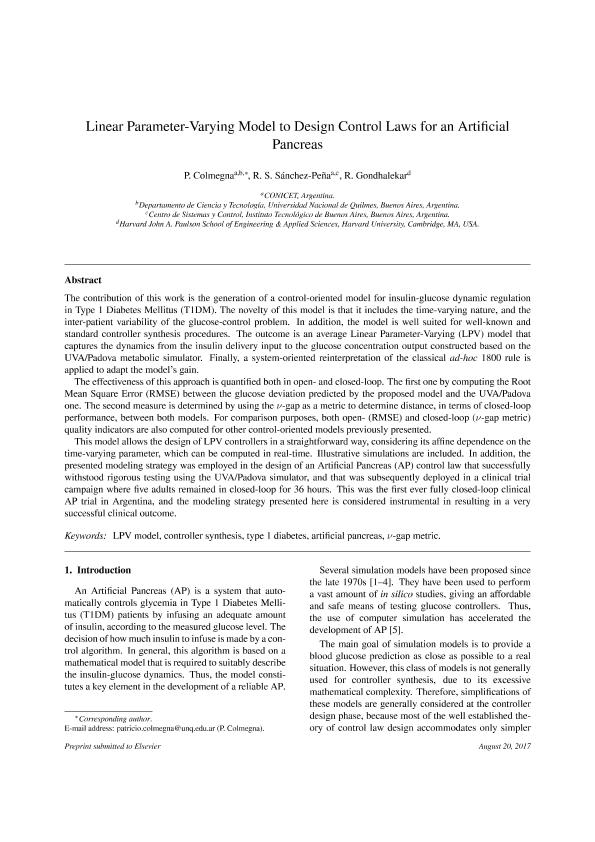Mostrar el registro sencillo del ítem
dc.contributor.author
Colmegna, Patricio Hernán

dc.contributor.author
Sanchez Peña, Ricardo Salvador

dc.contributor.author
Gondhalekar, R.
dc.date.available
2020-03-11T22:20:45Z
dc.date.issued
2018-02
dc.identifier.citation
Colmegna, Patricio Hernán; Sanchez Peña, Ricardo Salvador; Gondhalekar, R.; Linear parameter-varying model to design control laws for an artificial pancreas; Elsevier; Biomedical Signal Processing and Control; 40; 2-2018; 204-213
dc.identifier.issn
1746-8094
dc.identifier.uri
http://hdl.handle.net/11336/99251
dc.description.abstract
The contribution of this work is the generation of a control-oriented model for insulin-glucose dynamic regulation in type 1 diabetes mellitus (T1DM). The novelty of this model is that it includes the time-varying nature, and the inter-patient variability of the glucose-control problem. In addition, the model is well suited for well-known and standard controller synthesis procedures. The outcome is an average linear parameter-varying (LPV) model that captures the dynamics from the insulin delivery input to the glucose concentration output constructed based on the UVA/Padova metabolic simulator. Finally, a system-oriented reinterpretation of the classical ad-hoc 1800 rule is applied to adapt the model's gain. The effectiveness of this approach is quantified both in open- and closed-loop. The first one by computing the root mean square error (RMSE) between the glucose deviation predicted by the proposed model and the UVA/Padova one. The second measure is determined by using the ν-gap as a metric to determine distance, in terms of closed-loop performance, between both models. For comparison purposes, both open- (RMSE) and closed-loop (ν-gap metric) quality indicators are also computed for other control-oriented models previously presented. This model allows the design of LPV controllers in a straightforward way, considering its affine dependence on the time-varying parameter, which can be computed in real-time. Illustrative simulations are included. In addition, the presented modeling strategy was employed in the design of an artificial pancreas (AP) control law that successfully withstood rigorous testing using the UVA/Padova simulator, and that was subsequently deployed in a clinical trial campaign where five adults remained in closed-loop for 36 h. This was the first ever fully closed-loop clinical AP trial in Argentina, and the modeling strategy presented here is considered instrumental in resulting in a very successful clinical outcome.
dc.format
application/pdf
dc.language.iso
eng
dc.publisher
Elsevier

dc.rights
info:eu-repo/semantics/openAccess
dc.rights.uri
https://creativecommons.org/licenses/by-nc-sa/2.5/ar/
dc.subject
ARTIFICIAL PANCREAS
dc.subject
CONTROLLER SYNTHESIS
dc.subject
LPV MODEL
dc.subject
TYPE 1 DIABETES
dc.subject
Ν-GAP METRIC
dc.subject.classification
Sistemas de Automatización y Control

dc.subject.classification
Ingeniería Eléctrica, Ingeniería Electrónica e Ingeniería de la Información

dc.subject.classification
INGENIERÍAS Y TECNOLOGÍAS

dc.title
Linear parameter-varying model to design control laws for an artificial pancreas
dc.type
info:eu-repo/semantics/article
dc.type
info:ar-repo/semantics/artículo
dc.type
info:eu-repo/semantics/publishedVersion
dc.date.updated
2020-03-03T15:05:56Z
dc.journal.volume
40
dc.journal.pagination
204-213
dc.journal.pais
Países Bajos

dc.journal.ciudad
Amsterdam
dc.description.fil
Fil: Colmegna, Patricio Hernán. Consejo Nacional de Investigaciones Científicas y Técnicas; Argentina. Universidad Nacional de Quilmes. Departamento de Ciencia y Tecnología; Argentina
dc.description.fil
Fil: Sanchez Peña, Ricardo Salvador. Consejo Nacional de Investigaciones Científicas y Técnicas; Argentina. Instituto Tecnológico de Buenos Aires; Argentina
dc.description.fil
Fil: Gondhalekar, R.. Harvard University; Estados Unidos
dc.journal.title
Biomedical Signal Processing and Control

dc.relation.alternativeid
info:eu-repo/semantics/altIdentifier/url/https://www.sciencedirect.com/science/article/pii/S1746809417302306
dc.relation.alternativeid
info:eu-repo/semantics/altIdentifier/doi/http://dx.doi.org/10.1016/j.bspc.2017.09.021
Archivos asociados
